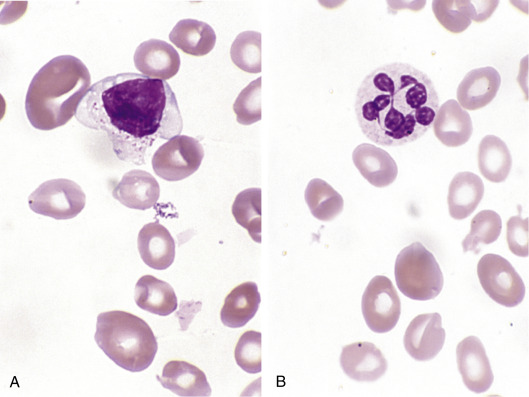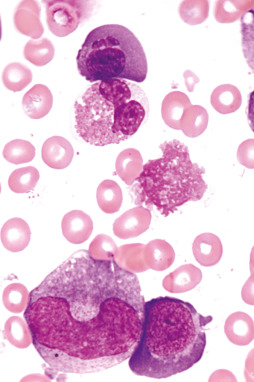AUTHOR: Shiva Kumar R. Mukkamalla, MD, MPH, FACP



DefinitionPernicious anemia (PA) is an autoimmune disease resulting from antibodies against gastric intrinsic factor and gastric parietal cells that results in vitamin B12 deficiency leading to megaloblastic anemia.
SynonymsMegaloblastic anemia resulting from vitamin B12 deficiency
Addison-Biermer anemia
Anemia, pernicious
| ICD-10CM CODES | | D51.0 | Vitamin B12 deficiency anemia due to intrinsic factor deficiency | | D51.8 | Other vitamin B12 deficiency anemias | | D51.9 | Vitamin B12 deficiency anemia, unspecified | | D51.1 | Vitamin B12 deficiency anemia due to selective vitamin B12 malabsorption with proteinuria |
|
Epidemiology & Demographics
- Increased incidence in females and older adults (40 to 70 yr)
- More frequent in patients of northern European ancestry
- Overall prevalence of undiagnosed PA after age 60 yr is 1.9%
- Prevalence is higher in women (2.7%), particularly in black women (4.3%)
- Associated with other autoimmune diseases (e.g., type 1 diabetes mellitus, Graves disease, Addison disease), along with possible Helicobacter pylori association
Physical Findings & Clinical Presentation12
- Mucosal pallor and/or glossitis (“beefy red tongue”)
- Angular cheilosis
- Mild jaundice (representative of intramedullary hemolysis of megaloblastic cells); “lemon yellow” skin due to pallor and jaundice
- Peripheral sensory neuropathy with paresthesias initially and absent reflexes in advanced disease
- Delirium or dementia
- Worsening weakness and possible subacute combined degeneration of spinal cord (Fig. E1)
- Loss of proprioception and an unsteady gait
- Gastrointestinal symptoms including anorexia, pyrosis, nausea, and vomiting
- Possible splenomegaly and mild hepatomegaly
Figure E1 Spinal cord in cobalamin deficiency.
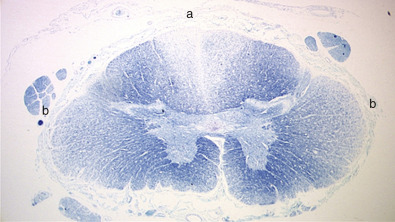
From Hoffman R et al: Hematology, basic principles and practice, ed 7, Philadelphia, 2018, Elsevier.
Etiology34
- Parietal cell antibodies are present in >70% of patients, while intrinsic factor antibodies are noted in >50% of patients.
- Atrophic gastric mucosa (Fig. E2) with achlorhydria.
- Inborn errors of cobalamin-cofactor synthesis are rare. Fig. E3 illustrates the components and mechanism of cobalamin absorption. An etiopathophysiologic classification of cobalamin deficiency is described in Section II.
Figure E2 Histologic features of stomach in pernicious anemia compared with normal.
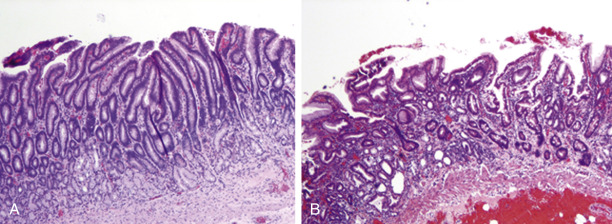
The normal gastric mucosa (A) is contrasted with that seen in pernicious anemia (B), in which there is atrophy of gastric glands, intestinal metaplasia with goblet cells, and loss of parietal cells (not visible at this magnification).
From Hoffman R et al: Hematology, basic principles and practice, ed 7, Philadelphia, 2018, Elsevier.
Figure E3 Components and mechanism of cobalamin absorption.
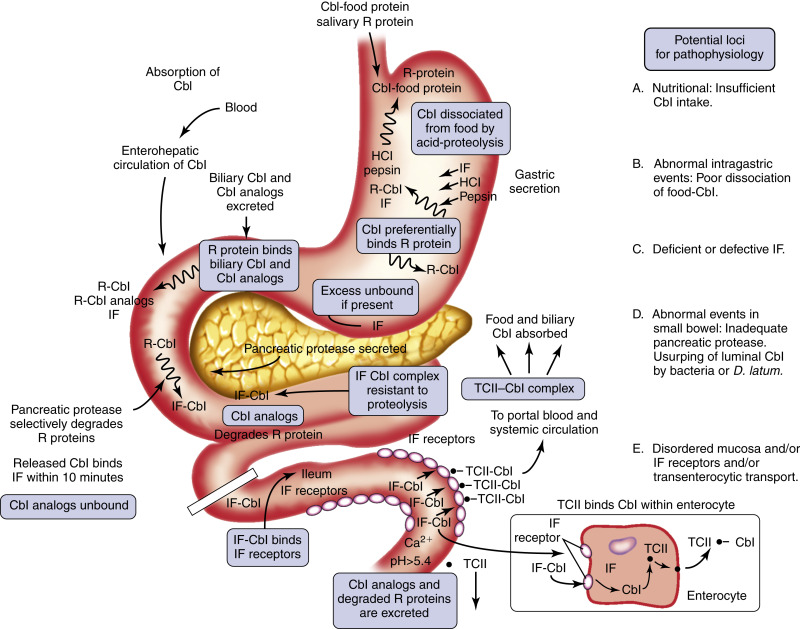
Cbl, Cobalamin; HCl, hydrochloric acid; IF, intrinsic factor; R, protein ligand; TCII, transcobalamin II.
From Hoffman R et al: Hematology, basic principles and practice, ed 6, Philadelphia, 2013, Elsevier.
 TREATMENT5-7
TREATMENT5-7
Comments
- Early manifestations of negative cobalamin balance are increased serum methylmalonic acid and total homocysteine levels. This occurs when the total cobalamin in serum is still in the low-normal range.
- Vitamin B12 deficiency that is allowed to progress for longer than 3 mo may produce permanent degenerative lesions of the spinal cord (e.g., subacute combined degeneration of spinal cord).
- Vitamin B12 deficiency may suppress signs of polycythemia vera; treatment of B12 deficiency may unmask this disorder.
- Blunted or impeded therapeutic response to vitamin B12 may be due to concurrent iron or folic acid deficiency, uremia, infections, or use of drugs with bone marrow suppressant properties. Causes of megaloblastosis not responding to therapy with cobalamin or folate are summarized in Table 3.
- Drugs that interfere with B12 absorption include metformin, colchicine, neomycin, and aminosalicylic acid.
- Patients must understand that cobalamin replacement therapy is lifelong.
- Self-injection of vitamin B12 may be taught in selected patients. Cost of monthly injections is less than $10.
- Patients who have had bariatric surgery should receive 1 mg of oral vitamin B12 per day indefinitely.
TABLE 3 Causes of Megaloblastosis Not Responding to Therapy With Cobalamin or Folate
| Wrong Diagnosis |
| Combined folate and cobalamin deficiencies being treated with only one vitamin |
| Associated iron deficiency |
| Associated hemoglobinopathy (e.g., sickle cell disease, thalassemia) |
| Associated anemia of chronic disease |
| Associated hypothyroidism |
From Hoffman R et al: Hematology, basic principles and practice, ed 7, Philadelphia, 2018, Elsevier.
Related ContentPernicious Anemia (Patient Information)
NONPHARMACOLOGIC THERAPYAvoid folic acid supplementation without proper vitamin B12 supplementation. Folic acid supplementation alone may result in hematologic remission in patients with vitamin B12 deficiency but will not treat or prevent neurologic manifestations.
ACUTE GENERAL RxTraditional therapy of cobalamin deficiency consists of intramuscular (IM) or deep subcutaneous (SC) injections of vitamin B12 1000 mcg/day for 1 wk, followed by 1000 mcg/mo, indefinitely. Monitor response and increase dosing if serum B12 levels decline.
CHRONIC Rx- Parenteral vitamin B12 1000 mcg/mo or intranasal cyanocobalamin 500 mcg/wk for the remainder of life.
- In patients who have no nervous system involvement, intranasal cyanocobalamin may be used in place of parenteral cyanocobalamin after hematologic parameters have returned to normal range. Macrocytosis correction can be noted during the first month of treatment. The initial dose of intranasal cyanocobalamin is 1 spray (500 mcg) in one nostril once per week. Nasal cyanocobalamin is expensive.
- Oral cobalamin (1000 to 2000 mcg/day) is also being effective in mild cases of pernicious anemia because approximately 1% of an oral dose is absorbed by passive diffusion, a pathway that does not require intrinsic factor. Cost for 1 mo of therapy is approximately $5. Consider returning to IM vitamin B12 supplementation if decline recurs.
DISPOSITIONAnemia generally resolves with appropriate cobalamin replacement therapy. Neurologic deficits, on the other hand, may be corrected only if treated early on.
REFERRALGastroenterology referral for endoscopy on diagnosis of PA followed by periodic surveillance endoscopies to rule out gastric adenocarcinoma or carcinoid tumors.



